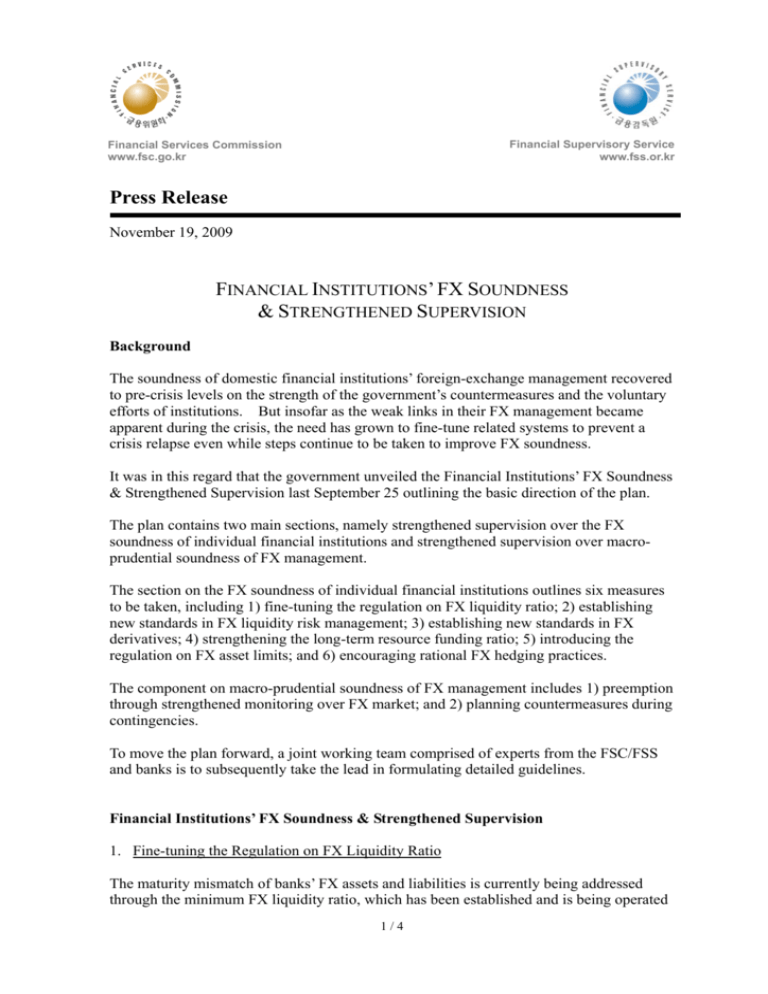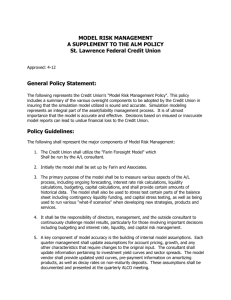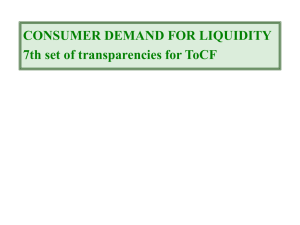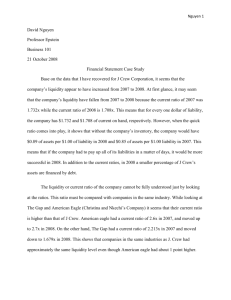Press Release - WordPress.com
advertisement

Financial Supervisory Service www.fss.or.kr Financial Services Commission www.fsc.go.kr Press Release November 19, 2009 FINANCIAL INSTITUTIONS’ FX SOUNDNESS & STRENGTHENED SUPERVISION Background The soundness of domestic financial institutions’ foreign-exchange management recovered to pre-crisis levels on the strength of the government’s countermeasures and the voluntary efforts of institutions. But insofar as the weak links in their FX management became apparent during the crisis, the need has grown to fine-tune related systems to prevent a crisis relapse even while steps continue to be taken to improve FX soundness. It was in this regard that the government unveiled the Financial Institutions’ FX Soundness & Strengthened Supervision last September 25 outlining the basic direction of the plan. The plan contains two main sections, namely strengthened supervision over the FX soundness of individual financial institutions and strengthened supervision over macroprudential soundness of FX management. The section on the FX soundness of individual financial institutions outlines six measures to be taken, including 1) fine-tuning the regulation on FX liquidity ratio; 2) establishing new standards in FX liquidity risk management; 3) establishing new standards in FX derivatives; 4) strengthening the long-term resource funding ratio; 5) introducing the regulation on FX asset limits; and 6) encouraging rational FX hedging practices. The component on macro-prudential soundness of FX management includes 1) preemption through strengthened monitoring over FX market; and 2) planning countermeasures during contingencies. To move the plan forward, a joint working team comprised of experts from the FSC/FSS and banks is to subsequently take the lead in formulating detailed guidelines. Financial Institutions’ FX Soundness & Strengthened Supervision 1. Fine-tuning the Regulation on FX Liquidity Ratio The maturity mismatch of banks’ FX assets and liabilities is currently being addressed through the minimum FX liquidity ratio, which has been established and is being operated 1/4 Financial Supervisory Service www.fss.or.kr Financial Services Commission www.fsc.go.kr on a 7-day, 1-month, and 3-month basis. The current standard, however, has given rise to a question of what level efficiency can be reached during a liquidity crunch since the ratio is arrived at on the assumption that all assets would be recoverable at any given time irrespective of an asset’s marketability. What’s more, indications point to the excessive regulatory costs associated with compliance in the case of the stringent 7-day gap ratio. The plan on ‘Financial Institutions’ FX Soundness & Strengthened Supervision’ has proposed to arrive at the liquidity ratio by reflecting the recoverable rate of FX assets. The recoverability of each respective asset class would also be determined by reflecting international standards and costs related to regulatory compliance. Liquidity Weightings (preliminary) Weightings (%) Before Asset class FX & deposits, FX call loans, FX purchases Interbank loans, Domestic import usance, Facility capital investment loans conditioned on installment repayment FX loans (incl. leases) Overseas demand based loans, Facility capital investment loans Operating capital, and others A – AAA BBB – A Government bonds 100 BBB & lower A – AAA FX securities Corporate bonds BBB – A BBB or lower Stocks Listed (incl. beneficiary certificates) Unlisted Futures assets Others The 7-day gap ratio is to be changed from the current 0% to above -3%. After 100 100 90 80 100 90 60 90 85 50 55 35 85 100 2. New Standards for FX Liquidity Risk Management Establishing a predictable framework of internal controls has become as imperative as the possibility of FX liquidity risk metastasizing into systemic risk. The current ‘Liquidity Risk Management Standards’, which came into effect last September, will be supplemented with new provisions entitled, ‘Characteristics Peculiarly Affecting FX Liquidity Management’ to establish the new ‘FX Liquidity Risk Management Standards’. The new standards will set mandatory guidelines on, among others, currency-specific liquidity risk management, the establishment and operations of an early warning system, limits on capital outflow during crises, and contingency funding plans. 2/4 Financial Supervisory Service www.fss.or.kr Financial Services Commission www.fsc.go.kr 3. Mandatory Minimum Holdings of Safe FX Assets The majority of financial institutions came to rely on the capital support of the government to counter the shortage in FX liquidity experienced during the recent crisis. In order to enable institutions to respond independently to situations where FX liquidity shortages follow outflows of FX capital in times of a crisis, mandatory minimums will be set for safe FX asset holdings. For such purposes, safe FX assets is defined as government bonds rated higher than single A and deposits in the central banks of countries rated higher than single A as well as corporate bonds rated higher than single A. In establishing holding limits, financial institutions will retain the option to adopt one of the following two in the interests of offsetting costs. i. Borrowings maturing in less than 1-year x 2/12 x (1-lowest refinancing rate), where the lowest refinancing rate is defined as the lowest weighted 3-month average refinancing rate exercised during the recent crisis. ii. More than the fixed ratio in relation to total FX assets, where the fixed ratio is initially set at 2%, but subject to review for adjustment according to prevailing conditions. 4. New Standards for FX Derivatives Trading Risk Management Despite the fact that excessive trading in FX derivatives by some of non-financial companies gave rise to considerable public outcry, financial institutions’ counterparty credit risk management has been inadequate. To address the issue, the currently in force ‘Derivatives Execution Best Practices’ will have incorporated more detailed guidelines outlining FX derivatives trades before establishing the new ‘FX Derivative Trading Risk Management Standards’. FX futures trading will thus be limited to a fixed ratio of a maximum of 125% vis-à-vis physical trade to prevent excessive FX hedging. In cases where an upward adjustment in the fixed ratio is deemed necessary, however, prior approval will be required from the Risk Management Committee, among possible others. The reporting of transactions executed with other financial institutions will be required while the transaction limit will extend to those entered into separately with individual producers. As part of credit risk management, the standards of ‘Derivatives Execution Best Practices’ will apply to all institutions dealing in foreign currencies with the exception of nonbanking financial institutions. Counterparties to the standards will not only apply to retail investors as provided for in the FSCMA but also sophisticated investors with the exception of financial institutions. 3/4 Financial Supervisory Service www.fss.or.kr Financial Services Commission www.fsc.go.kr Standards Application & Guidelines FSCMA-set retail investors FSCMA-defined Corporate investors sophisticated investors Financial institutions Applicability Yes Yes No Transactions limit Less than 100% Between 100-125% No limit 5. Tightened Regulations to Increase Mid- to long-term Financing in Foreign Loan Portfolios The current regulation on the ratio of mid- to long-term financing in foreign loan portfolios (mid- to long-term financing / mid- to long-term lending) is designed to increase long-term financing in banks' borrowing structure. However, the current ratio of 80% or more is ineffective, and some point out that regulating in terms of '1 year or more' is not in line with international standards. Thus, it was decided to change the criteria for mid- to long-term foreign loan financing from ‘1 year or more’ to ‘more than 1 year’ while the calculation standard and classification will be the same with short-term foreign loans. In addition, the ratio regulation will be tightened from the current 80% or more to 90% or more. Based on results next year, the ratio will gradually be revised upwards. Meanwhile, the ratio of '90% or more' is a minimum ratio, so the FSC will work towards tightening it to 100% or more in the first half of 2010. 6. Promotion of Reasonable FX Hedge Practices by Asset Management Companies The high foreign exchange hedge ratio of asset management companies in Korea is a major reason behind banks' short-term foreign borrowings. It is also pointed out that it restricts investors' choice of fund products. In this regard, it was decided to provide customers more information on forex hedge costs and effects through prospectus (To be reflected in 'Standard for Producing Corporate Public Announcement Form' in mid December and to be publically announced from 2010) and public announcements by the Korea Financial Investment Association (the system is currently under construction and is expected to be ready for operation in mid December following test drive in mid November). It was also decided to introduce investment products with different forex hedge ratios. 4/4 Financial Supervisory Service www.fss.or.kr Financial Services Commission www.fsc.go.kr In this connection, the Korea Financial Investment Association will revise the 'Working Rules on Standard Investment Recommendation' in mid December for mother funds to have various types of son funds with different hedge ratios. 7. Clarification of Rules over Mandatory Reporting of Foreign Exchange Transactions Current rules over mandatory reporting of foreign exchange transactions will be clarified with specific information on reporting content, term, etc. < Example: Bank's reporting rules > Report Foreign assets and liabilities, foreign capital financing by maturity, reporting of operation status as determined by Chairman of FSS ⇒ Report Term Foreign assets, classification of liabilities by time to maturity, and forex liquidity ratio monthly Status of maturing foreign borrowings monthly Financing and use of foreign capital quarterly 8. Foreign Asset Limit (leverage ratio) to be Further Discussed Financial companies' excessive asset increase and borrowing were also noted as a major culprit behind the recent crisis. To address this issue, the Basel Committee on Banking Supervision is currently reviewing the introduction of leverage ratio regulations. It was noted that similar regulations should apply to foreign asset transactions in Korea. Based on the results of the discussions of the Basel Committee and others, the FSC will specify how, what, and when to apply such regulations. * Example: Limit capital/foreign asset ratio to certain level Implementation The proposed measures are aimed at improving the system to enhance the soundness of foreign transactions and strengthen risk management competence of financial institutions. To ensure a smooth implementation, the measures will be introduced at levels that are achievable by the banking sector and will later be adjusted flexibly depending on institutional success and change in economic conditions. The measures will initially apply to the banking sector, and, in principle, the measures will apply equally to every bank. However, Korea Export-Import Bank, Korea Development Bank, and other banks where government loss protection is provided for by law and where the government holds 90% or more of ownership are exempted from the obligation to hold safe asset. Meanwhile, foreign bank branches are only subject to risk management 5/4 Financial Supervisory Service www.fss.or.kr Financial Services Commission www.fsc.go.kr standards on FX derivative transactions and reporting obligation; they will not be subject to liquidity ratio regulations and other direct regulations. Financial institutions other than banks are excluded from the application of the proposed measures. Based on the results in the banking sector, it will be further discussed whether to extend the measures to non-banking sectors. In determining the level of measures, the case of U.K. will be taken as a reference; however, domestic financial companies' profitability and compliance costs will also be taken into account. In principle, the proposed plan will be implemented from early 2010. The requirement of holding higher portions of marketable assets and the holding of safe foreign assets as a result of tightened regulations over foreign currency liquidity ratio will be enforced from July 2010 in consideration of the time that the banking sector need to adjust to new rules. Future Plans Moving ahead, the government is aiming at completing the revision of relevant statutes (Regulations and enforcement rules for supervision of banking sector) before the end of 2009 so that the proposed measures can be implemented in 2010. For further inquiries: Lee, J. Ernst Foreign Press Spokesperson Foreign Press & Relations Office Financial Services Commission Soomi Kim Foreign Press Spokesperson Public Affairs Office Financial Supervisory Service Tel: +82-2-2156-9582 Fax: +82-2-2156-9589 E-mail: happyhero@korea.kr Tel: +82-2-3145-5800 Fax: +82-2-3145-5808 E-mail: soomi.kim@fss.or.kr 6/4









